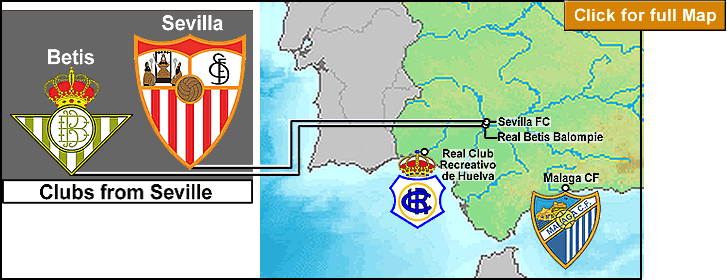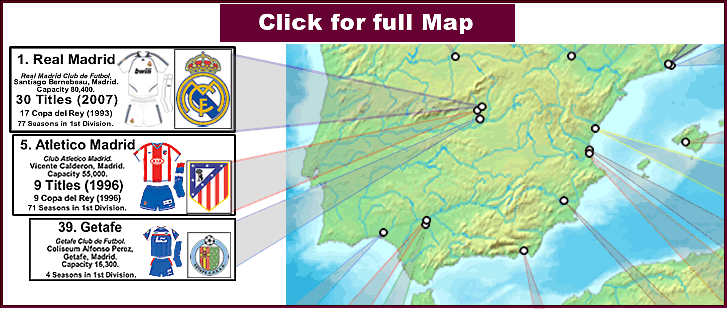
…
…
Note: to see my latest post on Spanish football, click on the following, category: Spain.
…
The 30th of August will see the opening of the 78th season of Spain’s Liga de Futbol Professional, popularly known as La Liga. The map shows the 20 clubs in the 2008-’09 season. Club crests are sized to reflect each club’s average attendance from 07/08.
Last season, La Liga averaged 29,124 per game {see this}. That figure will probably go down this season, though. This is primarily because Real Zaragoza, who drew 30,000 per game last season, were relegated, and one of the three promoted clubs is Numancia (who drew only around 5,000 a game last season).
Since 2002-’03, La Liga has been averaging between 28,500 and 29,200 per game. The way it stands now, La Liga has two clubs that draw over 60,000 (reigning champions Real Madrid, and Barcelona); five clubs that draw between 35,000 and 45,000 (Atletico Madrid, Valencia, Sevilla, Real Betis, and Athletic Bilbao); 9 clubs that draw between 17,000 and 24,000 (Murcia, Espanyol, Villarreal, Mallorca, Deportivo La Coruna, Valladolid, Racing Santander, Recreativo Huelva, and Osasuna); and some medium-small sized clubs that usually survive a year or to, or go straight back down to the Segunda Division. The exception to this last category has come to be Getafe, the rather tiny club from a heavily industrialized region just south of Madrid’s city center, who were formed in 1983. This club is hard pressed to draw more than 10,000 a game, yet has thrived in their first 4 seasons in La Liga, and made it to the Quarter-Finals of the UEFA Cup last season. Another example of this may be under way on the southeast coast, in eastern Andalusia, where top flight novices Almeria (established in 1989), finished in 8th place last season, and drew around 15,000 per game. {See this profile, from the Albion Road site}. Five years ago, new to the second tier, Almeria averaged only 5,800.
Thanks to Demis, of the Netherlands, for the base map {Click here}.
Thanks to European Football Statistics, for the attentance figures {Click here}.
Thanks to the Spanish Football & Sports site, for linking to this post {Click here}.



